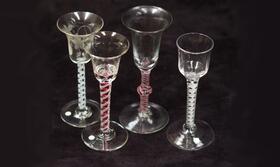Twist and Shout in Praise of Georgian Drinking Glasses
Twist and Shout in Praise of Georgian Drinking Glasses
By Elizabeth Talbot
There are many intrigues in life, such as how do ships find their way into bottles, how were Japanese wood and ivory puzzle balls made, and how can tiny Oriental quartz snuff bottles possibly be painted on the inside with intricate scenes to be enjoyed from the exterior? The answers lie in the pure skill and ingenuity of dedicated crafts people, artists who contrived an idea and perfected it, long before the scope of computers and technology intervened to map out designs and determine solutions, which we mostly rely on these days.
There are many such conundrums relating to the production techniques and decorative elements found in glass objects, centuries old and from all around the world: whole books are written on the subject. However, the arrival of an extensive private collection of Georgian glass has prompted my current focus on the fashion for “cotton twist stems” on drinking glasses in the English Georgian period of the late 18th Century.
Today, filigree glass is mostly associated with Venice, where it was first used in the second quarter of the 16th Century. The Venetians perfected the use of slender opaque glass rods, delicately encased in clear glass, to fashion intricate net-like patterns of astonishing complexity; but whilst wares are most recognisable as coming from this part of the world since the 1500’s, the technique was used by the Romans, and examples survive from many other countries throughout the centuries, including Germany, France, and Britain.
In Britain, filigree canes are most often found worked into the stems of delicate, beautiful, wine, cordial and liqueur glasses, and the actual making of the canes themselves demanded a high degree of craftsmanship on the part of the glass workers. They are known as opaque twist or enamel twist, and when entirely white, they are known as white twist or cotton twist. They became highly fashionable from about 1745 (having succeeded the air twist stem, the very English invention which appeared around 1730) and had reached their height of production by 1780. If they are found with the rare inclusion of a colour, such as red or blue, or a combination of opaque twists with air twists, it dates the piece to c.1765 or later.
The opaque white enamel used consisted materially of glass, and tin oxide such as was used in the glazing of Delftware. It was delivered to the glass makers in the form of bricks which were melted and drawn out into long threads of various thickness called “canes”. These canes were cut and placed in moulds, encased in clear molten glass, cooled, removed from the mould, re-heated and recoated within a larger mould. It was this intricate mass which was then drawn out and twisted until it was reduced to the required thickness; short lengths cut from the resulting rod formed the stems for glasses.
Over 100 varieties of opaque twist stems have been recorded, some of them highly complicated. The more technical they are, the rarer they are and therefore they are highly prized by collectors. The simpler single-series twists may pre-date the more elaborate double-series twists, or they may have co-existed for much of the time (experts are not sure), but by 1780 the cotton twist was out-moded.
By the end of the 18th Century, tastes had changed in line with the progressive capabilities of the British glass industry, and most decoration on stemmed glasses was then focussed on fine cutting and engraving. However, its end was quickened by the passing of an Act of Parliament in 1777, which not only doubled the existing duty introduced by the Glass Excise Act of 1745 (expressly passed to help raise money for Continental wars), but also imposed a tax on the enamel which was the raw material for the white or coloured canes used for the twists.
Opaque twist glasses produced much later than the Georgian period can often be found, and with values of original examples having grown sufficiently enough during the late 20th Century to encourage copying, circumspection is encouraged. Some examples are legitimate continuations of production skills which would otherwise be lost, but be wary of deliberate fakes and forgeries on the market, especially if spuriously aged.
Meanwhile, the featured private collection of over 50 lots of Georgian glass including a whole variety of drinking vessels, cotton twist glasses, toddy lifters, lace-makers lamps (or whale-oil lamps), and commemorative beakers, is to be sold in the next Special Antiques auction at TW Gaze Diss Auction Rooms on Thursday 5 August. Expectations range from £30 – 300 depending on the item. Catalogues online now with arrangements for viewing and bidding, either in person, via commission bids or live via the online platform the-saleroom.com.

